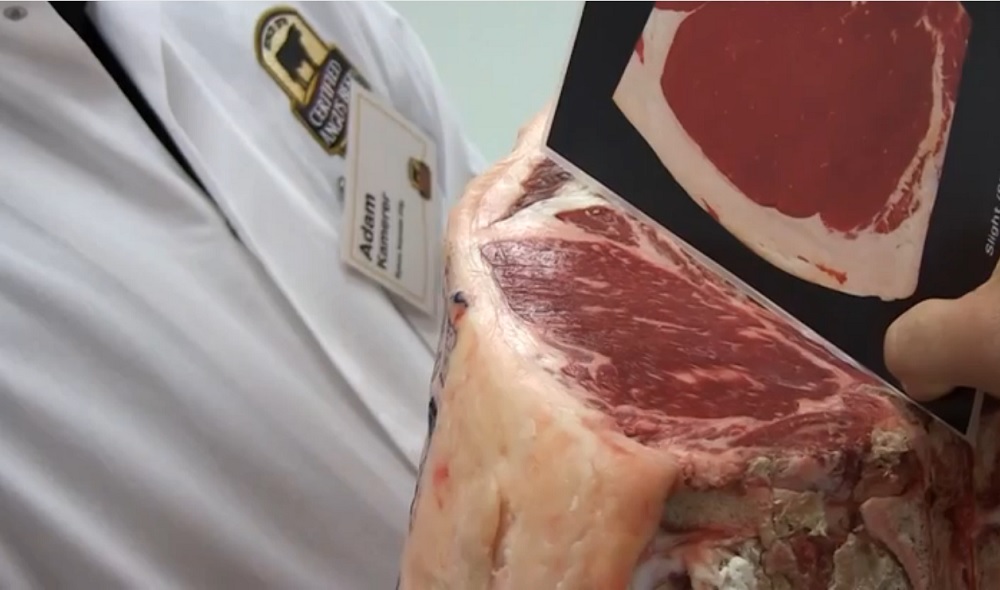
Agricultural News
Prime Certified Angus Beef - It's Still Profitable, Possible and Consumers Can't Get Enough of the Stuff
Thu, 15 Jun 2017 10:01:45 CDT
 Some think a dramatic increase in Prime grading beef spells oversupply. When will packers have enough?
Some think a dramatic increase in Prime grading beef spells oversupply. When will packers have enough?
"I can tell you, we haven't reached that point today," says Steve Williams, head of procurement for JBS USA. "I don't see a time in my lifetime when Prime's not a big premium. I just don't see it."
Supply of the uppermost tier of beef has doubled in recent years, with up to 6% of the nation's fed cattle harvest grading Prime. That has opened new doors, says Mark McCully, vice president of supply for the Certified Angus Beef ® (CAB®) brand.
"In a lot of cases, supply has fueled the demand, which in turn has given producers incentive to produce more," he says.
For the last decade, the average annual spread between Select and Prime ranged from $25 to $50/cwt., and about $35 for 2016.
"The last five years our percent Prime has doubled, and those spreads have stayed the same-the demand is there," Williams says, fending off myths that it might be simply a factor of cattle numbers: "Weights are up, beef production hasn't tailed off."
Bringing in his colleague in sales helps explain.
"In years past, consistency of supply has been hit or miss," says Chris Ross, program director for JBS USA. "Whether cost of gain is up or market factors due to weather-it's been a tough deal to get a consistent supply of Prime. Now, we're seeing that turn around and it's an upward trend, which really helps us from the sales side."
In the last five years, weekly Prime production on a carcass-weight basis rose 8.9 million pounds, from 13.7 million per week in 2012 to 22.6 million in 2016.
"It's given us a great opportunity to expand our customer base and really supply that demand," Ross says.
Cattlemen like Jerry Kusser, of Highmore, S.D., are seeing years of focus pay off.
"We wanted to know if we were going in the right direction and which ones made the most money," the rancher says of carcass data collection that goes back to the 1980s. He credits that, heavy use of artificial insemination and strict genetic selection for cowherd function and end-product merit for stellar grading ability.
Last year, 88% of his 458 steers qualified for CAB and CAB Prime, including 68% of that highest grade. The average hot carcass weight was 925 pounds (lb.).
"Prime cattle were once considered almost outliers that you couldn't predict," McCully says. "But the data we have and the progress we've made on genetics and understanding marbling deposition today has really proven that's not true."
In the Angus breed, there is a clear upward trend in the average expected progeny difference (EPD) for marbling. From 1972 to 2014, that EPD increased from -0.20 to 0.60, or 80% of a quality grade.
"Genetics would be the most important thing, and then environment goes on top. If genetics are the building blocks, the environment would be the next step," Williams says.
Drought-inspired culling has "amplified" the quality trend, McCully says. "The oldest genetics were eliminated, then replaced with young, current genetics that have far more Angus influence and carcass merit."
Wider use of DNA testing in both the seedstock and commercial sectors helps speed progress.
"We have a lot of selection tools with our genetics today that weren't available even five years ago," says Kansas cattleman Berry Bortz, who feeds calves from his own herd in a home feedyard near Preston, Kan.. "We can make progress today faster than we've ever been able to make it before."
Producers can make that directional change, while also improving cowherd function and performance.
"There's a lot of rhetoric in the industry that says these cattle aren't as good maternally," says Lee Leachman, Fort Collins, Colo., Kusser's genetic supplier. "We don't think that's right. The mistake a lot of people make is that they've seen some of the high-marbling cattle that created females that lacked adaptability in their environment, because they were bigger and heavier milking than what people wanted."
There is such diversity among Angus cattle that high-marbling, lower-input genetics are out there now, he says, and the same can be said for better ribeye and dressing percentage.
"You can find them and use them. Certainly the database and the EPDs and DNA tests now make all that easier," Leachman says.
To those like Mike Drury, western region president of Newport Meats, that's good to hear.
"On the East and West Coast, it's all about product and service differentiation," says Drury, Irvine, Calif. "Wanting to play at that high level, and then having inconsistency in there, your risk-reward for the operator is very high."
Colorado State University research shows, on average, just 3% of Prime middle meats are unacceptable to the consumer, compared to 34% for Select-grading cuts.
Cattlemen initiate that consumer-satisfaction chain.
"We are 100% reliant on what they do," Drury says. "I would just say don't waiver from the quality, because at the end of the day, that's all we have. No shortcuts."
That's motivation enough for cattlemen like Gerry Shinn of Jackson, Mo., to keep trying to beat their own grading records.
"That's why the premium is there. There's a few times when it will narrow down a bit, but day in and day out, it's always there," he says. "I've just observed that it's never difficult to sell a Prime."
Source - Certified Angus Beef
WebReadyTM Powered by WireReady® NSI
Top Agricultural News
More Headlines...





